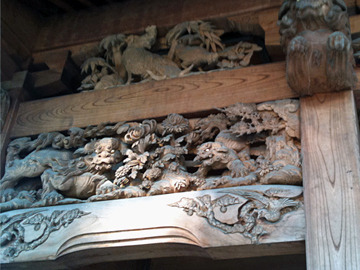Itz-offline - Itz_Offline



More Posts from Itz-offline and Others

werewolves can also do a biiig stretch

First time drawing a furry :>

They make me feel single in a good way🧌






小野神社(東京都多摩市) https://www.sa-ka-ki.com/jinja/tokyo/ono-tama/

Jef Bourgeau (American, b.1950) "The River Marsh," 2023
Using motifs to create thematic depth.
Motifs are one of the most powerful tools a writer has for weaving deeper meaning into a story.
What Is a Motif?
A motif is a repeated element in your story that highlights a theme. While similar to symbols, motifs are more dynamic and can evolve as your characters and story progress.
Symbol: A single red rose representing love. Motif: Flowers appearing throughout the story to represent different aspects of relationships—love, decay, growth, and loss.
Why Use Motifs?
They deepen your story’s meaning. Motifs give your readers something to latch onto, creating a sense of unity.
They enhance immersion. Repeated elements help ground readers in your world.
Tips for Crafting Effective Motifs
1. Choose a Motif That Fits Your Story’s Themes
Ask yourself: What’s the central idea of my story? Your motif should subtly reinforce that idea.
Theme: Resilience in the face of hardship. Motif: Cracked glass—a recurring image of something that’s damaged but still functional, reflecting the characters’ inner strength.
2. Use Motifs to Reflect Character Growth
A well-designed motif can evolve alongside your characters, reflecting their arcs.
In the beginning, a character always wears a watch to represent their obsession with time and control. By the end, they stop wearing the watch, symbolizing their acceptance of life’s unpredictability.
3. Keep It Subtle (But Consistent)
A motif shouldn’t feel like a flashing neon sign. It should quietly enhance the story without overpowering it.
If your motif is rain, don’t make every scene a thunderstorm. Use it sparingly—maybe it rains during moments of emotional turmoil or reflection, creating a subconscious link for the reader.
4. Use Recurrence to Build Meaning
The more your motif appears, the more it will resonate with readers. The key is repetition with variation.
In a story about family bonds, food could serve as a motif.
Early on: A tense family dinner where no one speaks. Later: A shared meal where characters open up and reconnect.
5. Connect Motifs to Emotion
Motifs are most effective when they evoke a visceral reaction in the reader.
Motif: A recurring song. First appearance: A father sings it to his child. Later: The same child hums it as an adult, remembering their father’s love. Final scene: The song plays during the child’s wedding, tying past and present together.
Examples of Motifs in Action
Motif: Mirrors
Theme: Self-perception vs. reality. A character avoids mirrors at first, unable to face their reflection. They slowly start using mirrors to confront their flaws. The final moment shows them standing confidently before a mirror, accepting themselves.
Motif: Keys
Theme: Freedom and control. A character collects keys, searching for one that unlocks their past. They find an old, rusted key, which leads them to uncover family secrets. The motif shifts to symbolize freedom when they lock a door behind them, leaving their past behind.
Motif: Birds
Theme: Longing for freedom. Early scenes show a bird trapped in a cage, reflecting the protagonist’s feelings. Later, the bird is released, symbolizing a turning point in the character’s journey.
Motif: The Ocean
Theme: Emotional depth and uncertainty. Calm waters reflect peace in the protagonist’s life. Stormy seas mirror moments of inner conflict.
Practical Exercise
1. Identify your story’s central theme.
2. Brainstorm objects, actions, or images that resonate with that theme.
3. Introduce the motif subtly early on.
4. Repeat it with variation, tying it to key emotional moments.
5. Bring it full circle by the end, letting the motif reinforce the resolution.
How do you go about choosing colors? Do you have a palette or use filters? Every time I try nothing looks cohesive enough and I don't understand how gradient maps work or if I'm doing it right lol but I really like the colors you use and was wondering what you do!
i don't use a palette, but i do use gradient maps pretty often o:
a gradient map takes the values in your image and reassigns them along the new gradient you've chosen. here's an example below - left side is a grayscale sketch, right side is with the gradient map applied. you can see how the darkest values are mapped to the purple tones, and lightest values are mapped to the peach/yellow.

my cheap trick to unifying color schemes is to choose colors, render an image > flatten and duplicate > apply gradient map > adjust opacity until it harmonizes. (that's my method in procreate, but you can use gradient maps as separate adjustment layers in photoshop and CSP). i still end up doing corrections afterwards, but it's a useful trick nonetheless. hope that helps!
To whom it may concern,
If you have had the misfortune of finding this note, then you are most likely the new owner of this property. And for that, I can only apologise and offer my condolences.
I have done everything within my power to ensure that this property never gains a new owner, but as the years go by and my body and mind begin to fail me, I fear that all of my preparations might have been in vain, as one can never hope to fully prepare for every eventuality.
As such, all I can do now is offer what little advice I have managed to gather over the years, in the hopes that whichever poor soul is reading this, will be able to avoid the fate that myself, and all those before me, were doomed to.
1 - Never extinguish or move, the lantern in the attic.
2 - If the lantern moves by itself, do not try and put it back in its usual place. It will return there in due time.
3 - Never use the back door. It does not lead to where you think it does, and it is locked for a reason.
4 - If said reason starts knocking or scratching at that door, do not respond, but be sure to cook a little extra that night, and try to pretend you do not notice when there is nothing left behind come the morn.
5 - Never remove flowers from the garden without having something on hand, to give back in return.
6 - Do not light the fireplace on the north wall. There is something living there, and the flames will be seen as an invitation.
7 - Those are not people by the lake, and they do not like it when you stare.
8 - Do not touch the apple tree. You cannot afford what they cost.
9 - The fourth step will squeak if you step on it during the day. Pay no attention to how it growls, when you do so at night.
10 - Never leave a mirror uncovered when you leave a room. These too, will be taken as an invitation, and not all guests are as polite as the chimney beast.
11 - Mysterious books should be avoided at all costs.
12 - No, that corner was not always that dark. Do not try and investigate it.
13 - Do not respond to the whispering you hear during the night. They do not only seek to wake you.
Good luck, dear stranger.
May you succeed, where all before you, have failed.




Fontainebleau State Park, Louisiana by Lana Gramlich
Love how tumblr has its own folk stories. Yeah the God of Arepo we’ve all heard the story and we all still cry about it. Yeah that one about the woman locked up for centuries finally getting free. That one about the witch who would marry anyone who could get her house key from her cat and it’s revealed she IS the cat after the narrator befriends the cat.
-
 mahoushoujokeitiichan liked this · 1 week ago
mahoushoujokeitiichan liked this · 1 week ago -
 nerds-and-lairs liked this · 1 week ago
nerds-and-lairs liked this · 1 week ago -
 birthlivepass liked this · 2 weeks ago
birthlivepass liked this · 2 weeks ago -
 captainunsavored liked this · 2 weeks ago
captainunsavored liked this · 2 weeks ago -
 liraka liked this · 3 weeks ago
liraka liked this · 3 weeks ago -
 heardwhereupdating liked this · 4 weeks ago
heardwhereupdating liked this · 4 weeks ago -
 choppedpiratetyphoon reblogged this · 1 month ago
choppedpiratetyphoon reblogged this · 1 month ago -
 choppedpiratetyphoon liked this · 1 month ago
choppedpiratetyphoon liked this · 1 month ago -
 d34dch3rry liked this · 1 month ago
d34dch3rry liked this · 1 month ago -
 mintyiron liked this · 1 month ago
mintyiron liked this · 1 month ago -
 spark204 liked this · 1 month ago
spark204 liked this · 1 month ago -
 analima1245 liked this · 1 month ago
analima1245 liked this · 1 month ago -
 bezerkerpie liked this · 1 month ago
bezerkerpie liked this · 1 month ago -
 chickennuggy626 liked this · 1 month ago
chickennuggy626 liked this · 1 month ago -
 stlaika liked this · 1 month ago
stlaika liked this · 1 month ago -
 runetta liked this · 1 month ago
runetta liked this · 1 month ago -
 wonder-grey reblogged this · 1 month ago
wonder-grey reblogged this · 1 month ago -
 shaidibuja liked this · 1 month ago
shaidibuja liked this · 1 month ago -
 writethepaperstars liked this · 1 month ago
writethepaperstars liked this · 1 month ago -
 sukarett0 liked this · 1 month ago
sukarett0 liked this · 1 month ago -
 randomcreativityspark liked this · 1 month ago
randomcreativityspark liked this · 1 month ago -
 cephalespis liked this · 1 month ago
cephalespis liked this · 1 month ago -
 weirddreamer liked this · 2 months ago
weirddreamer liked this · 2 months ago -
 holdyhope liked this · 2 months ago
holdyhope liked this · 2 months ago -
 gangletheamazingdigitalcircus liked this · 2 months ago
gangletheamazingdigitalcircus liked this · 2 months ago -
 daisyrings-and-rainclouds reblogged this · 2 months ago
daisyrings-and-rainclouds reblogged this · 2 months ago -
 streej liked this · 2 months ago
streej liked this · 2 months ago -
 i-am-the-chair liked this · 2 months ago
i-am-the-chair liked this · 2 months ago -
 rufus-gg liked this · 2 months ago
rufus-gg liked this · 2 months ago -
 ink-the-axolotl-rabbit liked this · 2 months ago
ink-the-axolotl-rabbit liked this · 2 months ago -
 yourfantik liked this · 2 months ago
yourfantik liked this · 2 months ago -
 oskidria liked this · 2 months ago
oskidria liked this · 2 months ago -
 mayoicecream liked this · 2 months ago
mayoicecream liked this · 2 months ago -
 lady-inkmare liked this · 2 months ago
lady-inkmare liked this · 2 months ago -
 deadgogol liked this · 2 months ago
deadgogol liked this · 2 months ago -
 freegardenercoffee liked this · 2 months ago
freegardenercoffee liked this · 2 months ago -
 the-tired-opossum liked this · 2 months ago
the-tired-opossum liked this · 2 months ago -
 happygoldfish liked this · 2 months ago
happygoldfish liked this · 2 months ago -
 neighborlynarwhal liked this · 2 months ago
neighborlynarwhal liked this · 2 months ago -
 motshine reblogged this · 2 months ago
motshine reblogged this · 2 months ago -
 phantomcorona liked this · 2 months ago
phantomcorona liked this · 2 months ago -
 wingbeltcreations liked this · 2 months ago
wingbeltcreations liked this · 2 months ago -
 unknown-plant-user liked this · 2 months ago
unknown-plant-user liked this · 2 months ago -
 vol-999 liked this · 2 months ago
vol-999 liked this · 2 months ago -
 llorar liked this · 2 months ago
llorar liked this · 2 months ago -
 achillesheelarrow liked this · 2 months ago
achillesheelarrow liked this · 2 months ago -
 jinxthechaotic liked this · 2 months ago
jinxthechaotic liked this · 2 months ago -
 cuppa-coma liked this · 2 months ago
cuppa-coma liked this · 2 months ago -
 writingdevil liked this · 2 months ago
writingdevil liked this · 2 months ago
